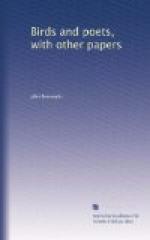Or the best lyric pieces, how like they are to certain bird-songs! —clear, ringing, ecstatic, and suggesting that challenge and triumph which the outpouring of the male bird contains. (Is not the genuine singing, lyrical quality essentially masculine?) Keats and Shelley, perhaps more notably than any other English poets, have the bird organization and the piercing wild-bird cry. This, of course, is not saying that they are the greatest poets, but that they have preeminently the sharp semi-tones of the sparrows and the larks.
But when the general reader thinks of the birds of the poets, he very naturally calls to mind the renowned birds, the lark and the nightingale, Old World melodists, embalmed in Old World poetry, but occasionally appearing on these shores, transported in the verse of some callow singer.
The very oldest poets, the towering antique bards, seem to make little mention of the song-birds. They loved better the soaring, swooping birds of prey, the eagle, the ominous birds, the vultures, the storks and cranes, or the clamorous sea-birds and the screaming hawks. These suited better the rugged, warlike character of the times and the simple, powerful souls of the singers themselves. Homer must have heard the twittering of the swallows, the cry of the plover, the voice of the turtle, and the warble of the nightingale; but they were not adequate symbols to express what he felt or to adorn his theme. Aeschylus saw in the eagle “the dog of Jove,” and his verse cuts like a sword with such a conception.
It is not because the old bards were less as poets, but that they were more as men. To strong, susceptible characters, the music of nature is not confined to sweet sounds. The defiant scream of the hawk circling aloft, the wild whinny of the loon, the whooping of the crane, the booming of the bittern, the vulpine bark of the eagle, the loud trumpeting of the migratory geese sounding down out of the midnight sky; or by the seashore, the coast of New Jersey or Long Island, the wild crooning of the flocks of gulls, repeated, continued by the hour, swirling sharp and shrill, rising and falling like the wind in a storm, as they circle above the beach or dip to the dash of the waves,—are much more welcome in certain moods than any and all mere bird-melodies, in keeping as they are with the shaggy and untamed features of ocean and woods, and suggesting something like the Richard Wagner music in the ornithological orchestra.
“Nor
these alone whose notes
Nice-fingered
art must emulate in vain,
But cawing
rooks, and kites that swim sublime
In still
repeated circles, screaming loud,
The jay,
the pie, and even the boding owl,
That hails
the rising moon, have charms for me,”
says Cowper. “I never hear,” says Burns in one of his letters, “the loud, solitary whistle of the curlew in a summer noon, or the wild mixing cadence of a troop of gray plovers in an autumnal morning, without feeling an elevation of soul like the enthusiasm of devotion or poetry.”




